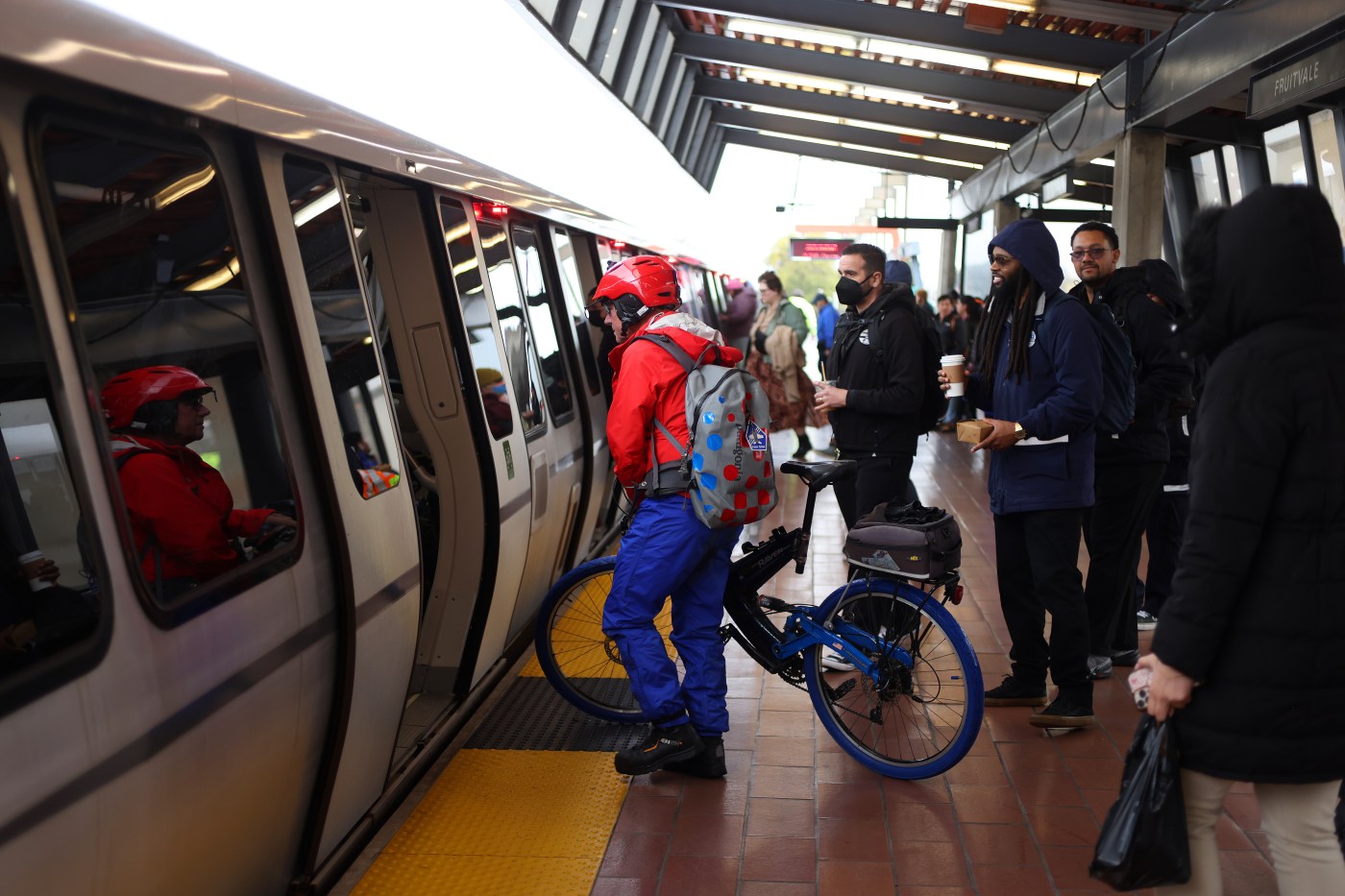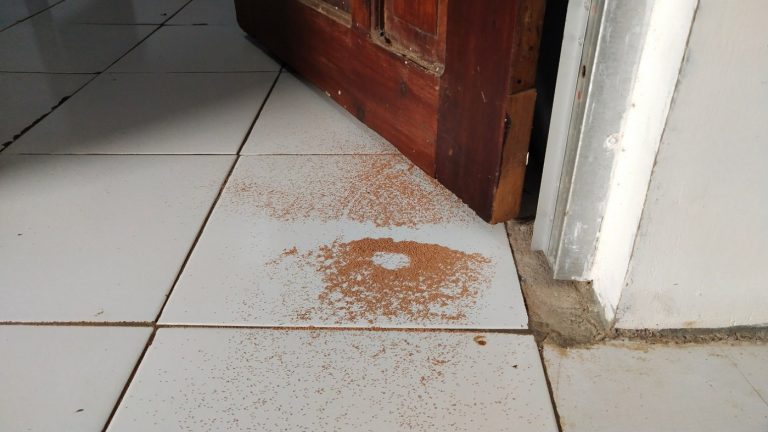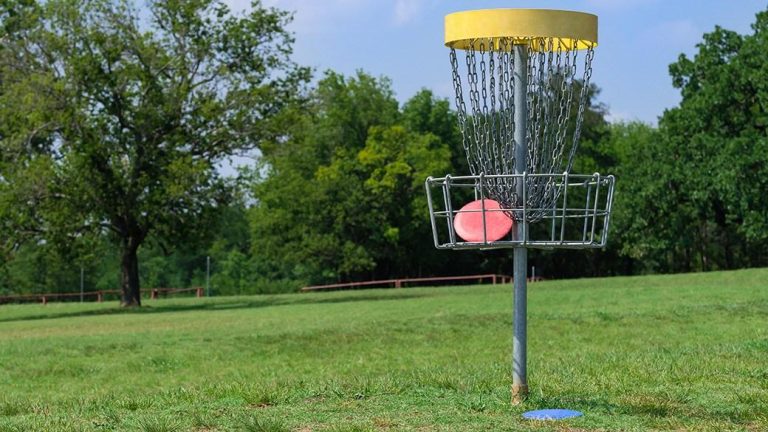Angel Beltran didn’t ride BART all that often a couple of years ago. Though he’d never been victimized by crime on the trains, he recalled his discomfort at sharing a car with an agitated fellow rider yelling obscenities, with no authorities present to intervene.
Now he’s riding twice a week to his classes at UC Berkeley where he studies digital arts. He said he’s noticed officers around the trains and feels safer riding.
“I’ve been taking it a lot lately now,” Beltran, 20, of Oakland, said. “It’s really not that bad.”
In response to depressed post-pandemic ridership and surveys showing riders overwhelmingly concerned about crime and cleanliness on the trains and in stations, BART started a “Safe & Clean Plan” in the fall of 2023, doubling officer presence systemwide and shortening trains to increase police visibility. So far, it appears to be working.
A traveler uses a phone application to pass through a security fare gate at the Fruitvale BART Station on Thursday, Feb. 6, 2025, in Oakland, Calif. In 2024, overall BART crime incidents decreased by 17% from 2023. (Aric Crabb/Bay Area News Group)
In year-end data for 2024, made available Feb. 4, the transit agency reported the overall rate of crime incidents on BART fell 17% from 2023, with violent crimes down 11% and property crimes down 18%.
“Overall crime is down on BART, and the sharpest decline is in property crimes,” said BART Police Chief Kevin Franklin. He said there were 536 fewer incidents of property crime compared with 2023 — including 229 fewer auto thefts from station parking lots, a 34% drop from 2023.
Related Articles
Street closures in San Francisco to affect Muni routes during NBA All-Star Weekend events
East Bay BART rider’s guide to getting to NBA All-Star Weekend
Track equipment problem closes down BART service in East Bay
San Jose affordable housing development could sprout near BART stop
SUV occupant who died after crash onto East Bay BART tracks is identified
Like other public transit agencies, BART has experienced depressed ridership since the peak of the COVID-19 pandemic from 2020-2022 with many former commuters working from home. The resulting drop in fare receipts has blown a hole in the system’s budget and spurred pleas to local and state officials for a bailout to avoid massive service cuts.
BART officials said it’s hard to quantify the overall costs of the Safe & Clean Plan — an $8.5 million police pay adjustment meant to help fill vacancies was offset by $9 million in savings from shortening trains. The agency is spending $500,000 per station to staff restrooms in an unspecified number of high-volume stations, and $850,000 for elevator attendants at four busy San Francisco stations. The gate replacement program is $90 million but is expected to increase fare receipts.
The BART system of 50 stations spanning more than 131 miles from Richmond south through Oakland to San Jose and Antioch and Dublin west to San Francisco faces ongoing structural budget deficits ranging from $375 million to more than $400 million per year beginning in 2027.
But the effort to improve safety and cleanliness is helping draw more riders back. In 2024, BART ridership reached 50.7 million, a 6.5% increase from 47.6 million in 2023. BART had 117 million riders in 2019 before the COVID-19 pandemic.
The BART safety effort increased visibility not only of sworn officers but unarmed crisis intervention specialists and transit ambassadors, Franklin said. Running trains with fewer cars has allowed police to increase their visibility on trains and platforms while using the same number of staff.
“With fewer train cars to patrol,” Franklin said, “more ground can be covered.”
Additional measures include maintaining more than 4,000 surveillance cameras to speed officer response time, installing more LED lighting in station platforms and parking areas to eliminate dark spots, enforcing smoking and drug use bans and conducting welfare checks on homeless people in and around stations. BART also is improving access gates to reduce fare evasion and increasing cleaning crews.
BART passengers said they see the improvements and feel safer.
“I feel like the safety is good, and I’ve seen significant improvements over the past couple of years,” said Reece Bell, 29, who normally uses BART to commute five days a week to work from the Oakland neighborhood of Rockridge to Warm Springs. Bell said he is seeing fewer and fewer of the things that once made him feel uncomfortable.
Jeamne Taylor, 31, of West Oakland, agreed.
“I’ve seen people get punched and then saw a guy bring a giant ladder onto the train and just kind of was swinging the ladder around in a way that was like gonna hit people, and that would make me feel not great,” Taylor said. “Nothing has happened in the last six months that I’ve been riding that has made me feel uncomfortable.”
Bell, who often rides BART at night for his job working in human resources, said he’s noticed BART staff checking fares and “a lot more police presence.”
“I’ve noticed a very quick response time from people when there are problems, and I’ve been on some trains where some people are having some rough go of it, some episodes,” Bell said. “I’m pretty surprised, and that’s encouraging.”












